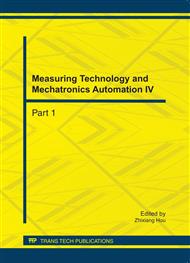p.168
p.172
p.177
p.181
p.185
p.190
p.196
p.200
p.205
Method of Parallel Active Power Filter Compensation on 3-Phase 3-Wire Nonlinear Unbalanced Load System
Abstract:
The parallel active power filter has been accepted by users because of its’ installing and removing without disturbing other users and so its’ detecting and controlling algorithms have been studied with large efforts .A method about direction of active power flow (DAPF ) was raised in present paper under condition of the 3-phase asymmetrical voltage and 3-wire nonlinear unbalanced load. It’s means that detected currents on the point of common coupling can be put into two parts according the active power flow direction ,one of which is called positive direction current and another is called negative direction current .then decompose the asymmetrical voltage and positive directional current with Symmetrical Component Method. We can obtain the reference current components with clear physical meaning for the paralleled active power filter .The method shows there are several harmful power components could not be eliminated with parallel active power filter.
Info:
Periodical:
Pages:
185-189
Citation:
Online since:
October 2011
Authors:
Price:
Сopyright:
© 2012 Trans Tech Publications Ltd. All Rights Reserved
Share:
Citation:


